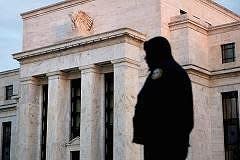Think you know what the Fed will do? Guess again


The most recent deliberations among Federal Reserve officials point to a central bank that is at its most divided self since the financial crisis.
True, the voting among Open Markets Committee members casts the appearance of near-unanimity, a credit to outgoing Chairman Ben Bernanke 's skills at consensus building or at least the appearance thereof.
But within the minutes of the December meeting is a Fed standing at the crossroads of a post-crisis economy being guided by mid-crisis monetary policy.
(Read more: Minutes show Fed cautious toward cutting QE )
The FOMC session was a critical one: At the meeting, the group voted 11-1 to begin curtailing-or "tapering," in market lingo-its monthly bond-buying program known as quantitative easing .
The central bank had been purchasing $45 billion a month of Treasurys and $40 billion of mortgage-backed securities and voted to reduce the pace of each by $5 billion.
At a news conference afterward, Bernanke said the FOMC at each of its subsequent meetings will conduct further $10 billion decreases until QE comes to an end. Most Wall Street experts took him at his word and anticipate the liquidity injections to be history once 2013 is in the books.
The minutes, though, reflect no such certainty. They indicate quite the contrary, in fact, when relating the discussion over how the Fed would proceed with tapering.
"Among those inclined to begin to reduce the pace of asset purchases at this meeting, many favored a modest initial reduction accompanied by guidance indicating that decisions regarding future reductions would depend on economic and financial developments as well as the efficacy and costs of purchases."
After all, Bernanke is in the final two weeks of his chairmanship before Janet Yellen takes over, and he'll have no say on what happens going forward. There seemed a strong tendency for the Fed to keep its options open.
"Members also stressed the need to underscore that the pace of asset purchases was not on a preset course and would remain contingent on the Committee's outlook for the labor market and inflation as well as its assessment of the efficacy and costs of purchases." (Emphasis added)
For investors, the nuances over language are important.
While the link between higher stock market prices and QE is the subject of hot debate, the fact remains that the Fed's balance sheet expanded 33 percent in 2013 and the S&P 500 (^GSPC) rose 29 percent-a fairly close correlation.
Though stocks rose in the immediate aftermath of the December tapering announcement, 2014 has been a flat year.
There is a second, and perhaps even more consequential, leg to Fed policy that also seems to be a point of internal contention: How and when to begin raising interest rates.
(Read more: Why inflation threat could lead to a 'panic taper' )
The Fed's near-zero policy rate has been a cornerstone, keeping mortgages cheap and allowing companies a low-cost way to finance operations and in particular stock buybacks and dividends.
Fed officials have said they won't start raising rates until unemployment falls to 6.5 percent and inflation reaches 2.5 percent. But recent developments seem to have caused the Fed to rethink its position.
(Read more: What are investors to make of ugly jobs report? )
While no one is calling for an outright repeal of the targets, there appears to be plenty of chatter toward amending language now that the jobless rate is only two-tenths of a percentage point away from the rates benchmark:
"A number of members thought that the forward guidance should emphasize the importance of inflation as a factor in their decisions.
"Accordingly, almost all members agreed to add language indicating the Committee's anticipation, based on its current assessment of additional measures of labor market conditions, indicators of inflation pressures and inflation expectations, and readings on financial developments, that it would be appropriate to maintain the current target range for the federal funds rate well past the time that the unemployment rate declines below 6.5 percent, especially if projected inflation continues to run below the Committee's longer-run objective." (Emphasis added)
The latest Consumer Price Index numbers show inflation rising, but to just 1.5 percent on an annualized basis. That remains well below the Fed target and consistent with the lackluster range in the post-crisis years.
If that trend continues, the Fed is unlikely to raise rates even if unemployment falls below 6.5 percent. The falling jobless number, at any rate, is largely the result of a reduction in labor participation than it is robust employment growth, as evidenced by December's paltry 74,000 gain that coincided with a 0.3 percentage point unemployment rate decline.
"Over time, we anticipate the Fed will increase focus on its inflation mandate, thus keeping policy easier for longer," Ethan Harris, co-head of global economics research at Bank of America Merrill Lynch, said in a report for clients. "As a result, we expect a patient and gradual end to the current pace of accommodation."
The Fed has yet one more worry: How the markets are reacting.
(Read more: 'Lofty' market ripe for at least 10% drop: Goldman )
Minutes note the dangers of how "the complexity and interconnectedness of large financial institutions, along with some apparent increases in investor appetite for higher-yielding assets and associated pressures on underwriting standards remained potential sources of risk to the financial system."
Managing that risk, and conveying a clear message to the markets, will be something the Fed wrestles with long after Bernanke is gone, with the path forward likely to defy market expectations.
-By CNBC's Jeff Cox. Follow him on Twitter @JeffCoxCNBCcom .
More From CNBC
Afraid of stocks? Then look here
Here's what you need to know in muni bond market
Volcker rule changes bring relief to small banks

